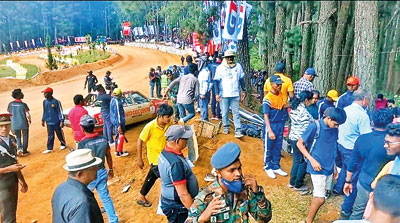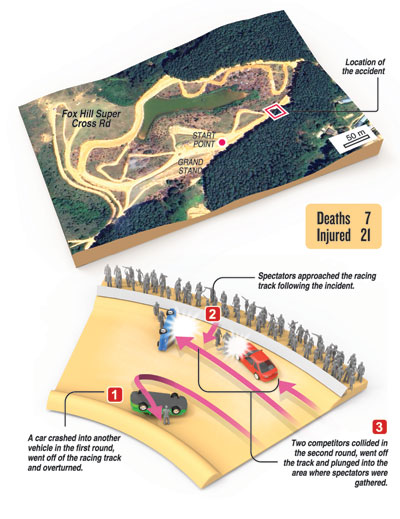News
Fox Hill racing organiser defend drivers, but deaths and injuries raise many questions
View(s):By Hafsa Sabry
The tragedy took place on April 21 at the Fox Hill racing track, owned by the Sri Lanka army in Diyatalawa, Uva Province. It was during the 18th race out of 24 in the 1,500-cc Ford Laser Mazda 323 category that two cars lost control and collided with a group of spectators. At present, 10 people are warded at the Badulla General Hospital, with two in critical condition in intensive care. Among them is a 16-year-old girl who has suffered brain damage.
Two race car drivers were arrested by the police and were remanded until April 30 by the Bandarawela Magistrate’s Court, but granted bail later. The drivers, who are being treated at the Badulla General hospital and said to be out of danger, were arrested on charges of dangerous driving.
A racer and former secretary of Sri Lanka Automobile Sports (SLAS), Rizvi Farook, who has 28 years of experience at the Fox Hill Supercross, attested to the safety standards at the track, considering it one of the safest in the country.

The Fox Hill Supercross race resumed this year after a hiatus of five years
He emphasised the organisers’ meticulous approach to safeguarding both drivers and spectators.
He was saddened by the tragedy and extended heartfelt condolences to the families of those who lost their lives.
He also emphasised the importance of the community moving forward and continuing to embrace race car driving, which is, for many, a passion. He stressed the need for strict measures to ensure that spectators are kept at a safe distance.
He said accidents on race car tracks can occur due to various factors, and that pinpointing a single cause can be challenging. It is not uncommon for race cars to topple or skid, given the high speeds and dynamic nature of racing.
He explained that factors such as reduced visibility due to sand and dust kicked up by other cars, changes in airflow affecting control, tyre issues, uneven surfaces, and drivers’ loss of control, all contribute to the risk. From the available photographs and videos, it appears that one car made contact with another, causing it to lose control and skid onto the earth bank where spectators were.
Rasika Kumara, a Major General of the Sri Lankan Army, said the tragedy could have been avoided if spectators had adhered to the simple rule of staying within designated sections. He expressed empathy towards the spectators, acknowledging their curiosity about witnessing a toppled car moments before the accident. “If I were there, I might have done the same out of curiosity.’’
Moments before the tragedy, a car toppled and skidded onto the earth bank of the race track. About 150–200 spectators moved close to the track to take a look at the toppled car. Shortly after, two more cars collided with the crowd that had gathered to witness the incident.

“Even though police, army, and marshals were positioned near the race track to prevent the crowd from entering an unauthorised area, no one was able to control them as it all happened under a minute, 30-40 seconds,’’ said a higher official of Sri Lanka Automobile Sports (SLAS) who requested anonymity.
Warnings were printed on entry tickets and displayed at the racing track and spectator zone. Despite being considered one of the safest tracks by organisers and racers, the crash has left everyone stunned.
There was a designated “no go area” of 30-40 feet between the spectator area to the race track. Unfortunately, people had entered the area, putting themselves at risk.
He also asserted that it’s unfortunate for the drivers to be held accountable, as it’s not solely their responsibility. “We at the SLAS stand by our drivers.’’
He claimed that it’s noteworthy that not a single car veered off the track to the spectator area; it was still inside the track after colliding, which is a common occurrence in car racing events.’’
About 15,000 are indirectly dependent on this motor car and motorcycle industry, spanning from tyre-changing mechanics to chair arrangers and banner installers, as well as vendors. About 2,000 people are indirectly involved in supporting the event.

Warnings are printed on the tickets
The SLAS official claimed that Rs 200 million was being spent at the event, including sponsorships.
“We, in collaboration with the Sri Lanka army, are devising plans to install circular guardrails constructed from galvanised iron (GI material) for future events. This aims to restrict access to the designated no-entry zone,’’ he said.
However, all expenses related to the funerals, transport, and other arrangements were covered by the army, as confirmed by the SLAS official.
Discussions for compensating the families who lost their loved ones are underway. The SLAS, along with the Sri Lanka army and the Ministry of Sports, are planning to contribute to the compensation, although the families have said that it doesn’t matter to them anymore.
The Sri Lanka Army appointed a committee of seven senior officers chaired by a major general to investigate. Another two independent bodies were appointed by SLAS and by the Ministry of Sports. Further action will be taken based on the report by the committees appointed.
Members of the committees are on-site investigating. Video footage and photographs are being reviewed. The investigation will last about two weeks. “The investigation needs a little time, the report cannot be submitted in two to three days,’’ said Major General Rasika Kumara.

The scene of the tragedy. Pix by Nayanananda Buwaneka
Further, the police launched investigations by recording key statements from the organisers, and it was revealed that the dusty racing track was not appropriately dampened, which may have led to fatalities.
DIG Nihal Thalduwa, the police media spokesperson, said organisers can claim anything they want, but from videos, the extent of dust on the track could be noticed.
“If they had properly dampened the road and the track, we could have avoided vehicles colliding.
“Even the racers would have faced significant challenges racing across a track where visibility is significantly impaired. It is their responsibility. When they couldn’t see the track properly, they should have stopped the cars or at least attempted to control their speed. The negligence of both the drivers and the organisers, along with the spectators, collectively led to this tragic accident.’’
He emphasised that a police report has been submitted to court. A key finding from the organisers’ statement is that the police determined the track to be excessively dusty for a car race.
He said medical checks on the race car drivers were necessary to determine whether they were under the influence of alcohol or any other illegal substances. This was to help confirm whether negligence on the drivers’ part contributed to the tragic incident, he claimed.
The SLAS official clarified that blood tests by the hospital confirmed that the race car drivers were not under the influence of alcohol or any other illegal substances. This incident is deemed to be purely related to the dynamics of race car driving.
Regarding pre-race testing for drivers, the SLAS official stated that, while it is highly costly, they are open to addressing any issues. “If there are any concerns or suspicions regarding a driver’s condition, they are committed to investigating the matter thoroughly.”
Speaking anonymously, the SLAS official addressed the tragic loss of the grandfather and granddaughter from Mirahawatta, Welimada. “The sister of the child claimed that she had warned the grandfather not to take the little sister near the track to see the toppled car because it wasn’t safe. Despite the warning, he still took her. While she survived the initial crash, it’s possible she died from injuries caused by the stampede.’’

Rasika Abeynaike, a member of the Sri Lanka army rugby team stationed at Salawa camp in Kosgama, was a spectator. He had completed his education at Embilipitiya Maha Vidyalaya, joined the army engineer corps, and was scheduled for a transfer to the Udawalawa army camp on April 22. According to family sources, his final rites were held in the Galaha area of Kandy.
Other victims included Matara residents Ganesh Kamalanath and Aruna Shantha, who were close friends. One was a father of three children, and the other of two. Ashen Heenatigala, 20, from Akuressa in Matara, was awaiting his A/Level results. The other victim was Chaminda Niroshan from Seeduwa.
The Fox Hill Supercross race resumed this year after a hiatus of five years.
Initially halted due to the Easter terrorist attacks in 2019, racing resumed, only to be suspended again, following the race track deaths.
The best way to say that you found the home of your dreams is by finding it on Hitad.lk. We have listings for apartments for sale or rent in Sri Lanka, no matter what locale you're looking for! Whether you live in Colombo, Galle, Kandy, Matara, Jaffna and more - we've got them all!

